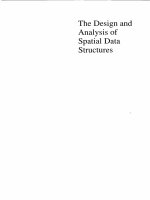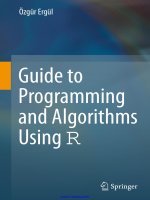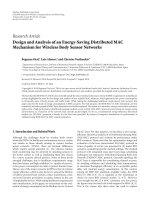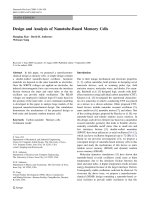Biostatistical design and analysis using r m logan (wiley, 2010)
Bạn đang xem bản rút gọn của tài liệu. Xem và tải ngay bản đầy đủ của tài liệu tại đây (3.58 MB, 577 trang )
Biostatistical Design and Analysis Using R
A Practical Guide
Murray Logan
A John Wiley & Sons, Inc., Publication
Biostatistical Design and Analysis Using R
Companion website
A companion website for this book is available at:
www.wiley.com/go/logan/r
The website includes figures from the book for downloading.
Biostatistical Design and Analysis Using R
A Practical Guide
Murray Logan
A John Wiley & Sons, Inc., Publication
This edition first published 2010, 2010 by Murray Logan
Blackwell Publishing was acquired by John Wiley & Sons in February 2007. Blackwell’s publishing program has
been merged with Wiley’s global Scientific, Technical and Medical business to form Wiley-Blackwell.
Registered office: John Wiley & Sons Ltd, The Atrium, Southern Gate, Chichester, West Sussex, PO19 8SQ, UK
Editorial offices: 9600 Garsington Road, Oxford, OX4 2DQ, UK
The Atrium, Southern Gate, Chichester, West Sussex, PO19 8SQ, UK
111 River Street, Hoboken, NJ 07030-5774, USA
For details of our global editorial offices, for customer services and for information about how to apply for
permission to reuse the copyright material in this book please see our website at www.wiley.com/wiley-blackwell
The right of the author to be identified as the author of this work has been asserted in accordance with the
Copyright, Designs and Patents Act 1988.
All rights reserved. No part of this publication may be reproduced, stored in a retrieval system, or transmitted, in
any form or by any means, electronic, mechanical, photocopying, recording or otherwise, except as permitted by
the UK Copyright, Designs and Patents Act 1988, without the prior permission of the publisher.
Wiley also publishes its books in a variety of electronic formats. Some content that appears in print may not be
available in electronic books.
Designations used by companies to distinguish their products are often claimed as trademarks. All brand names
and product names used in this book are trade names, service marks, trademarks or registered trademarks of
their respective owners. The publisher is not associated with any product or vendor mentioned in this book. This
publication is designed to provide accurate and authoritative information in regard to the subject matter covered.
It is sold on the understanding that the publisher is not engaged in rendering professional services. If professional
advice or other expert assistance is required, the services of a competent professional should be sought.
Library of Congress Cataloguing-in-Publication Data
Logan, Murray.
Biostatistical design and analysis using R : a practical guide / Murray Logan.
p. cm.
Includes bibliographical references and index.
ISBN 978-1-4443-3524-8 (hardcover : alk. paper) – ISBN 978-1-4051-9008-4 (pbk. : alk. paper)
1. Biometry. 2. R (Computer program language) I. Title.
QH323.5.L645 2010
570.1 5195 – dc22
2009053162
A catalogue record for this book is available from the British Library.
Typeset in 10.5/13pt Minion by Laserwords Private Limited, Chennai, India
Printed and bound in Singapore
1
2010
Contents
Preface
R quick reference card
General key to statistical methods
1
Introduction to R
1.1 Why R?
1.2 Installing R
1.2.1 Windows
1.2.2 Unix/Linux
1.2.3 MacOSX
1.3 The R environment
1.3.1 The console (command line)
1.4 Object names
1.5 Expressions, Assignment and Arithmetic
1.6 R Sessions and workspaces
1.6.1 Cleaning up
1.6.2 Workspaces
1.6.3 Current working directory
1.6.4 Quitting R
1.7 Getting help
1.8 Functions
1.9 Precedence
1.10 Vectors - variables
1.10.1 Regular or patterned sequences
1.10.2 Character vectors
1.10.3 Factors
1.11 Matrices, lists and data frames
1.11.1 Matrices
1.11.2 Lists
1.11.3 Data frames - data sets
xv
xix
xxvii
1
1
2
2
2
3
3
4
4
5
6
6
7
7
8
8
9
10
11
12
13
15
16
16
17
18
vi
CONTENTS
1.12 Object information and conversion
1.12.1 Object information
1.12.2 Object conversion
1.13 Indexing vectors, matrices and lists
1.13.1 Vector indexing
1.13.2 Matrix indexing
1.13.3 List indexing
1.14 Pattern matching and replacement (character search and replace)
1.14.1 grep - pattern searching
1.14.2 regexpr - position and length of match
1.14.3 gsub - pattern replacement
1.15 Data manipulation
1.15.1 Sorting
1.15.2 Formatting data
1.16 Functions that perform other functions repeatedly
1.16.1 Along matrix margins
1.16.2 By factorial groups
1.16.3 By objects
1.17 Programming in R
1.17.1 Grouped expressions
1.17.2 Conditional execution – if and ifelse
1.17.3 Repeated execution – looping
1.17.4 Writing functions
1.18 An introduction to the R graphical environment
1.18.1 The plot() function
1.18.2 Graphical devices
1.18.3 Multiple graphics devices
1.19 Packages
1.19.1 Manual package management
1.19.2 Loading packages
1.20 Working with scripts
1.21 Citing R in publications
1.22 Further reading
2
Data sets
2.1 Constructing data frames
2.2 Reviewing a data frame - fix()
2.3 Importing (reading) data
2.3.1 Import from text file
2.3.2 Importing from the clipboard
2.3.3 Import from other software
2.4 Exporting (writing) data
2.5 Saving and loading of R objects
2.6 Data frame vectors
2.6.1 Factor levels
18
18
20
20
21
22
23
24
24
25
26
26
26
27
28
29
30
30
30
31
31
32
34
35
36
39
40
42
42
45
45
46
47
48
48
49
50
50
51
51
52
53
54
54
CONTENTS
2.7 Manipulating data sets
2.7.1 Subsets of data frames – data frame indexing
2.7.2 The %in% matching operator
2.7.3 Pivot tables and aggregating datasets
2.7.4 Sorting datasets
2.7.5 Accessing and evaluating expressions within the context of
a dataframe
2.7.6 Reshaping dataframes
2.8 Dummy data sets - generating random data
3
vii
56
56
57
58
58
59
59
62
Introductory statistical principles
3.1 Distributions
3.1.1 The normal distribution
3.1.2 Log-normal distribution
3.2 Scale transformations
3.3 Measures of location
3.4 Measures of dispersion and variability
3.5 Measures of the precision of estimates - standard errors and
confidence intervals
3.6 Degrees of freedom
3.7 Methods of estimation
3.7.1 Least squares (LS)
3.7.2 Maximum likelihood (ML)
3.8 Outliers
3.9 Further reading
65
66
67
68
68
69
70
4
Sampling and experimental design with R
4.1 Random sampling
4.2 Experimental design
4.2.1 Fully randomized treatment allocation
4.2.2 Randomized complete block treatment allocation
76
76
83
83
84
5
Graphical data presentation
5.1 The plot() function
5.1.1 The type parameter
5.1.2 The xlim and ylim parameters
5.1.3 The xlab and ylab parameters
5.1.4 The axes and ann parameters
5.1.5 The log parameter
5.2 Graphical Parameters
5.2.1 Plot dimensional and layout parameters
5.2.2 Axis characteristics
5.2.3 Character sizes
5.2.4 Line characteristics
5.2.5 Plotting character parameter - pch
85
86
86
87
88
88
88
89
90
92
93
93
93
71
73
73
73
74
75
75
viii
CONTENTS
5.3
5.4
5.5
5.6
5.7
5.8
5.9
5.10
5.11
5.12
6
5.2.6 Fonts
5.2.7 Text orientation and justification
5.2.8 Colors
Enhancing and customizing plots with low-level plotting
functions
5.3.1 Adding points - points()
5.3.2 Adding text within a plot - text()
5.3.3 Adding text to plot margins - mtext()
5.3.4 Adding a legend - legend()
5.3.5 More advanced text formatting
5.3.6 Adding axes - axis()
5.3.7 Adding lines and shapes within a plot
Interactive graphics
5.4.1 Identifying points - identify()
5.4.2 Retrieving coordinates - locator()
Exporting graphics
5.5.1 Postscript - poscript() and pdf()
5.5.2 Bitmaps - jpeg() and png()
5.5.3 Copying devices - dev.copy()
Working with multiple graphical devices
High-level plotting functions for univariate (single variable) data
5.7.1 Histogram
5.7.2 Density functions
5.7.3 Q-Q plots
5.7.4 Boxplots
5.7.5 Rug charts
Presenting relationships
5.8.1 Scatterplots
Presenting grouped data
5.9.1 Boxplots
5.9.2 Boxplots for grouped means
5.9.3 Interaction plots - means plots
5.9.4 Bargraphs
5.9.5 Violin plots
Presenting categorical data
5.10.1 Mosaic plots
5.10.2 Association plots
Trellis graphics
5.11.1 scales() parameters
Further reading
Simple hypothesis testing – one and two population tests
6.1 Hypothesis testing
6.2 One- and two-tailed tests
6.3 t-tests
96
98
98
99
99
100
101
102
104
107
108
113
113
114
114
114
115
115
115
116
116
117
118
119
120
120
120
125
125
125
126
127
128
128
128
129
129
132
133
134
134
136
136
CONTENTS
6.4
6.5
6.6
6.7
6.8
6.9
7
Assumptions
Statistical decision and power
Robust tests
Further reading
Key for simple hypothesis testing
Worked examples of real biological data sets
ix
137
137
139
139
140
142
Introduction to Linear models
7.1 Linear models
7.2 Linear models in R
7.3 Estimating linear model parameters
7.3.1 Linear models with factorial variables
7.3.2 Linear model hypothesis testing
7.4 Comments about the importance of understanding the structure
and parameterization of linear models
151
152
154
156
156
162
8
Correlation and simple linear regression
8.1 Correlation
8.1.1 Product moment correlation coefficient
8.1.2 Null hypothesis
8.1.3 Assumptions
8.1.4 Robust correlation
8.1.5 Confidence ellipses
8.2 Simple linear regression
8.2.1 Linear model
8.2.2 Null hypotheses
8.2.3 Assumptions
8.2.4 Multiple responses for each level of the predictor
8.2.5 Model I and II regression
8.2.6 Regression diagnostics
8.2.7 Robust regression
8.2.8 Power and sample size determination
8.3 Smoothers and local regression
8.4 Correlation and regression in R
8.5 Further reading
8.6 Key for correlation and regression
8.7 Worked examples of real biological data sets
167
168
169
169
169
169
170
170
171
171
172
173
173
176
176
177
178
178
179
180
184
9
Multiple and curvilinear regression
9.1 Multiple linear regression
9.2 Linear models
9.3 Null hypotheses
9.4 Assumptions
9.5 Curvilinear models
9.5.1 Polynomial regression
208
208
209
209
210
211
211
164
x
CONTENTS
9.6
9.7
9.8
9.9
9.10
9.11
9.5.2 Nonlinear regression
9.5.3 Diagnostics
Robust regression
Model selection
9.7.1 Model averaging
9.7.2 Hierarchical partitioning
Regression trees
Further reading
Key and analysis sequence for multiple and complex
regression
Worked examples of real biological data sets
214
214
214
214
215
218
218
219
219
224
10 Single factor classification (ANOVA)
10.0.1 Fixed versus random factors
10.1 Null hypotheses
10.2 Linear model
10.3 Analysis of variance
10.4 Assumptions
10.5 Robust classification (ANOVA)
10.6 Tests of trends and means comparisons
10.7 Power and sample size determination
10.8 ANOVA in R
10.9 Further reading
10.10 Key for single factor classification (ANOVA)
10.11 Worked examples of real biological data sets
254
254
255
255
256
258
259
259
261
261
262
262
265
11 Nested ANOVA
11.1 Linear models
11.2 Null hypotheses
11.2.1 Factor A - the main treatment effect
11.2.2 Factor B - the nested factor
11.3 Analysis of variance
11.4 Variance components
11.5 Assumptions
11.6 Pooling denominator terms
11.7 Unbalanced nested designs
11.8 Linear mixed effects models
11.9 Robust alternatives
11.10 Power and optimisation of resource allocation
11.11 Nested ANOVA in R
11.11.1 Error strata (aov)
11.11.2 Linear mixed effects models (lme and lmer)
11.12 Further reading
11.13 Key for nested ANOVA
11.14 Worked examples of real biological data sets
283
284
285
285
285
286
286
289
289
290
290
292
292
293
293
294
294
294
298
CONTENTS
12 Factorial ANOVA
12.1 Linear models
12.2 Null hypotheses
12.2.1 Model 1 - fixed effects
12.2.2 Model 2 - random effects
12.2.3 Model 3 - mixed effects
12.3 Analysis of variance
12.3.1 Quasi F-ratios
12.3.2 Interactions and main effects tests
12.4 Assumptions
12.5 Planned and unplanned comparisons
12.6 Unbalanced designs
12.6.1 Missing observations
12.6.2 Missing combinations - missing cells
12.7 Robust factorial ANOVA
12.8 Power and sample sizes
12.9 Factorial ANOVA in R
12.10 Further reading
12.11 Key for factorial ANOVA
12.12 Worked examples of real biological data sets
13 Unreplicated factorial designs – randomized block and simple repeated
measures
13.1 Linear models
13.2 Null hypotheses
13.2.1 Factor A - the main within block treatment effect
13.2.2 Factor B - the blocking factor
13.3 Analysis of variance
13.4 Assumptions
13.4.1 Sphericity
13.4.2 Block by treatment interactions
13.5 Specific comparisons
13.6 Unbalanced un-replicated factorial designs
13.7 Robust alternatives
13.8 Power and blocking efficiency
13.9 Unreplicated factorial ANOVA in R
13.10 Further reading
13.11 Key for randomized block and simple repeated
measures ANOVA
13.12 Worked examples of real biological data sets
14 Partly nested designs: split plot and complex repeated measures
14.1 Null hypotheses
14.1.1 Factor A - the main between block treatment effect
14.1.2 Factor B - the blocking factor
xi
313
314
314
315
316
317
317
320
321
321
321
322
322
324
325
327
327
327
328
334
360
363
363
364
364
364
365
366
368
370
370
371
371
371
371
372
376
399
400
400
401
xii
CONTENTS
14.2
14.3
14.4
14.5
14.6
14.7
14.8
14.1.3 Factor C - the main within block treatment effect
14.1.4 AC interaction - the within block interaction effect
14.1.5 BC interaction - the within block interaction effect
Linear models
14.2.1 One between (α), one within (γ ) block effect
14.2.2 Two between (α, γ ), one within (δ) block effect
14.2.3 One between (α), two within (γ , δ) block effects
Analysis of variance
Assumptions
Other issues
14.5.1 Robust alternatives
Further reading
Key for partly nested ANOVA
Worked examples of real biological data sets
401
402
402
402
402
402
403
403
403
408
408
408
409
413
15 Analysis of covariance (ANCOVA)
15.1 Null hypotheses
15.1.1 Factor A - the main treatment effect
15.1.2 Factor B - the covariate effect
15.2 Linear models
15.3 Analysis of variance
15.4 Assumptions
15.4.1 Homogeneity of slopes
15.4.2 Similar covariate ranges
15.5 Robust ANCOVA
15.6 Specific comparisons
15.7 Further reading
15.8 Key for ANCOVA
15.9 Worked examples of real biological data sets
448
450
450
450
450
451
452
453
454
455
455
455
455
457
16 Simple Frequency Analysis
16.1 The chi-square statistic
16.1.1 Assumptions
16.2 Goodness of fit tests
16.2.1 Homogeneous frequencies tests
16.2.2 Distributional conformity - Kolmogorov-Smirnov tests
16.3 Contingency tables
16.3.1 Odds ratios
16.3.2 Residuals
16.4 G-tests
16.5 Small sample sizes
16.6 Alternatives
16.7 Power analysis
16.8 Simple frequency analysis in R
466
467
469
469
469
469
469
470
472
472
473
474
474
475
CONTENTS
16.9 Further reading
16.10 Key for Analysing frequencies
16.11 Worked examples of real biological data sets
xiii
475
475
477
17 Generalized linear models (GLM)
17.1 Dispersion (over or under)
17.2 Binary data - logistic (logit) regression
17.2.1 Logistic model
17.2.2 Null hypotheses
17.2.3 Analysis of deviance
17.2.4 Multiple logistic regression
17.3 Count data - Poisson generalized linear models
17.3.1 Poisson regression
17.3.2 Log-linear Modelling
17.4 Assumptions
17.5 Generalized additive models (GAM’s) - non-parametric GLM
17.6 GLM and R
17.7 Further reading
17.8 Key for GLM
17.9 Worked examples of real biological data sets
483
485
485
485
487
488
488
489
489
489
492
493
494
495
495
498
Bibliography
R index
Statistics index
531
535
541
Companion website for this book: wiley.com/go/logan/r
Preface
R is a powerful and flexible statistical and graphical environment that is freely
distributed under the GNU Public Licencea for all major computing platforms
(Windows, MacOSX and Linux). This open source licence along with a relatively
simple scripting syntax has promoted diverse and rapid evolution and contribution. As
the broader scientific community continues to gain greater instruction and exposure
to the overall project, the popularity of R as a teaching and research tool continues to
accelerate.
It is now widely acknowledged that R proficiency as a scientific skill set is becoming
increasingly more desirable and useful throughout the scientific community. However,
as with most open source developments, the emphasis of the R project remains on
the expansive development of tools and features. Applied documentation still remains
somewhat sparse and somewhat incomprehensible to the average biologist. Whilst
there are a number of excellent texts on R emerging, the bulk of these texts are devoted
to the R language itself. Any featured examples therein are used primarily for the
purpose of illustrating the suite of commonly used R features and procedures, rather
than to illustrate how R can be used to perform common biostatistical analyses.
Coinciding with the increasing interest in R as both a learning and research tool
for biostatistics, has been the success of a relatively new major biostatistics textbook
(Quinn and Keough, 2002). This text provides detailed coverage of most of the major
statistical concepts and tests that biologists are likely to encounter with an emphasis on
the practical implementation of these concepts with real biological data. Undoubtedly,
a large part of the appeal of this book is attributable to the extensive use of real biological
examples to augment and reinforce the text. Furthermore, by concentrating on the
information biologists need to implement their research, and avoiding the overuse of
complex mathematical descriptions, the authors have appealed to those biologists who
don’t require (or desire) a knowledge of performing or programming entire analyses
from scratch. Such biologists tend to use statistical software that is already available
and specifically desire information that will help them achieve reliable statistical and
biological outcomes. Quinn and Keough (2002) also advocate a number of alternative
a
This is an open source licence that ensured that the application as well as its source code is freely
available to use, modify and redistribute.
xvi
PREFACE
texts that provide more detailed coverage of specific topics and that also adopt this real
example approach.
Typically, most biostatistical texts focus on the principles of design and analysis
without extending into the practical use of software to implement these principles. Similarly, R/S-plus texts tend to concentrate on documenting and showcasing
the features of R without providing much of a biostatistical account of the principles behind the features or illustrating how these tools can be extended to achieve
comprehensive real world analyses. Consequently, many biological students and
professionals struggle to translate the theoretical advice into computational outcomes. Although some of these difficulties can be addressed after extensively reading
through a number of software references, many of the difficulties remain. The inconsistency and incompatibility between theory texts and software reference texts is
mainly the result of differing intentions of the two genres and is a source of great
frustration.
The reluctance of biostatistical texts to promote or instruct on any particular
statistical software (except for extremely specialized cases where historically only a
single dedicated program was available) is in part an acknowledgment of the diversity
of software packages available (each of which differs substantially in the range of
features offered as well as the user interface and output provided). Furthermore,
software upgrades generally involve major alternations to the way in which preexisting tasks are performed and thus being associated with a single software package
tends to restrict the longevity and audience of the text. In contrast, although contributers are constantly extending the feature set of R environments, overall the
project maintains a consistent user interface. Consequently, there is currently both
a need and opportunity for a text that fills the gap between biostatistics texts and
software texts, so as to assist biologists with the practical side of performing statistical
analysis.
Many biological researchers and students have at one stage or another used one or
other of the major biostatistics texts and gained a good understanding of the principles.
However, from time to time (and particularly when preparing to generate a new design
or analyse a new data set), they require a quick refresher to help remind them of the
issues and principles relevant to their current design and/or analysis scenarios. In most
cases, they do not need to re-read the more discursive texts and in many cases express a
reluctance to invest large amounts of valuable research time doing so. Therefore, there
is also a need for a quick reference that summarizes the key concepts of contemporary
biostatistics and leads users step-wise through each of the analysis procedures and
options. Such a guide would also help users to identify their areas of statistical naivete
and enable them to return to a more comprehensive text with a more focused and
efficient objective.
Therefore, the intended focus of this book will be to highlight the major concepts,
principles and issues in contemporary biostatistics as well as demonstrate how to use R
(as a research design, analysis and presentation tool) to complete examples from major
biostatistics textbooks. In so doing, this proposed text acknowledges the important
role that statistical software and real examples play in reinforcing statistical principles
and practices.
PREFACE
xvii
Hence in summary, the intentions of the book are three-fold
(i) To provide very brief refresher summaries of the main concepts, issues and options involved
in a range of contemporary biostatistical analyses
(ii) To provide key guides that steps users through the procedures and options of a range of
contemporary biostatistical analyses
(iii) To provide detailed R scripts and documentation that enable users to perform a range of real
worked examples from statistics texts that are popular among biological and environmental
scientists
Worked examples
Where possible and appropriate, this book will make use the same examples that appear
in the popular biostatistical texts so as to take advantage of the history and information
surrounding those examples as well as any familiarity that users may have with those
examples. Having said this however, access to these other texts will not be necessary to
get good value out of the materials.
Website
This book is augmented by a website (./go/logan/r) which
includes:
• raw data sets and R analysis scripts associated with all worked examples
• the biology package that contains many functions utilized in this book
• an R reference card containing links to pages within the book
Typographical convensions
Throughout this book, all R language objects and functions will be printed in courier
(monospaced) typeface. Commands will begin with the standard R command prompt
(<) and lines continuing on from a previous line will begin with the continuation
prompt (+). In syntax used within the chapter keys, dataset is used as an example
and should be replaced by the name of the actual data frame when used. Similarly, all
vector names should be replaced by the names used to denote the various variables in
your data set.
Acknowledgements
The inspiration for this book came primarily from Gerry Quinn and Mick Keough
towards whom I am both indebted and infuriated (in equal quantities). As authors
of a statistical piece themselves, they should known better than to encourage others
xviii
PREFACE
to attempt such an undertaking! I also wish to acknowledge the intellectualizing and
suggestions of Patrick Baker and Andrew Robinson, the former of whom’s regular
supply of ideas remains a constant source of material and torment. Countless numbers
of students and colleagues have also helped refine the materials and format of this
book. As almost all of the worked examples in this book are adapted from the major
biostatistical texts, the contributions of these other authors cannot be overstated.
Finally, I would like to thank Nat, Kara, Saskia and Anika for your support and
tolerance while I wrote this ‘‘extremely quite boring book with rid-ic-li-us pictures’’
(S. Logan, age 7).
xix
> LETTERS the 26 upper-case letters of the English
alphabet (see page 17)
> letters the 26 lower-case letters of the English
alphabet (see page 17)
Built in constants
> ?function Getting help on a function (see page 8)
> help(function) Getting help on a function (see
page 8)
> example(function) Run the examples associated
with the manual page for the function (see page 8)
> demo(topic) Run an installed demonstration script
(see page 8)
> apropos("topic") Return names of all objects in
search list that match ‘‘topic’’ (see page 9)
> help.search("topic") Getting help about a concept (see page 9)
> help.start() Launch R HTML documentation
(see page 9)
Getting help
> q() Quitting R (see page 8)
> ls() List the objects in the current environment (see
page 7)
> rm(...) Remove objects from the current environment (see page 7)
> setwd(dir) Set the current working directory (see
page 7)
> getwd() Get the current working directory (see
page 7)
Session management
R quick reference card
> source("file") Input, parse and sequentially
evaluate the file (see page 45)
> sink("file") Redirect non-graphical output to
file
> read.table("file", header=T, sep=) Read
data in table format and create a data frame, with
variables in columns (see page 51)
> read.table("clipboard", header=T,
sep=) Read data left on the clipboard in table format and create a data frame, with variables in columns
(see page 51)
> read.systat("file.syd", to.data.frame=T)
Read SYSTAT data file and create a data frame (see
page 52)
Importing/Exporting
> installed.packages() List of all currently
installed packages (see page 44)
> update.packages() Update installed packages
(see page 44)
package(s)
> install.packages(pkgs) Install
(pkgs) from CRAN mirror (see page 45)
R CMD INSTALL package Install an add-on package
(see page 43)
> library(package) Loading an add-on package
(see page 45)
> data(name) Load a data set or structure inbuilt into
R or a loaded package.
Packages
> month.name English names of the 12 months of the
year
> month.abb Abbreviated English names of the 12
months of the year
> pi π − the ratio of a circles circumference to diameter (see page 105)
> factor(x) Convert the vector (x) into a factor (see
page 15)
Factors
> paste(..., sep=) Combine multiple vectors
together after converting them into character vectors
(see page 13)
> substr(x, start, stop) Extract substrings
from a character vector (see page 14)
Character vectors
> c(...) Concatenate objects (see page 6)
> seq(from, to, by=, length=) Generate a
sequence (see page 12)
> rep(x, times, each) Replicate each of the values
of x (see page 13)
Generating Vectors
> read.spss("file.sav", to.data.frame=T)
Read SPSS data file and create a data frame (see page 52)
> as.data.frame(read.mtp("file.mtp")) Read
Minitab Portable Worksheet data file and create a data
frame (see page 52)
> read.xport("file") Read SAS XPORT data file
and create a data frame (see page 52)
> write.table(dataframe, "file",
row.names=F, quote=F, sep=) Write the contents
of a dataframe to file in table format (see page 53)
> save(object, file="file.RData") Write the
contents of the object to file (see page 53)
> load(file="file.RData") Load the contents of
a file (see page 53)
> dump(object, file="file") Save the contents
of an object to a file (see page 53)
xx
> data.frame(...) Convert a set of vectors into a
data frame (see page 49)
Data frames
> list(...) Generate a list of named (for arguments
in the form name=x) and/or unnamed (for arguments in
the form (x) components from the sequence of objects
(see page 17)
Lists
> matrix(x,nrow, ncol, byrow=F) Create a
matrix with nrow and/or ncol dimensions out of a
vector (x) (see page 16)
> cbind(...) Create a matrix (or data frame) by
combining the sequence of vectors, matrices or data
frames by columns (see page 16)
> rbind(...) Create a matrix (or data frame) by
combining the sequence of vectors, matrices or data
frames by rows (see page 16)
> rownames(x) Read (or set with <-) the row names
of the matrix (x) (see page 17)
> colnames(x) Read (or set with <-) the column
names of the matrix (x) (see page 17)
Matrices
> factor(x, levels=c()) Convert the vector (x)
into a factor and define the order of levels (see page 15)
> gl(levels, reps, length, labels=) Generate a factor vector by specifying the pattern of levels
(see page 15)
> levels(factor) Lists the levels (in order) of a
factor (see page 54)
> levels(factor) <- Sets the names of the levels of
a factor (see page 54)
Vectors
> x[i] Select the ith element (see page 21)
> x[i:j] Select the ith through jth elements inclusive
(see page 21)
> x[c(1,5,6,9)] Select specific elements (see
page 21)
> x[-i] Select all except the ith element (see page 21)
> x["name"] Select the element called "name" (see
page 21)
> x[x > 10] Select all elements greater than 10 (see
page 22)
> x[x > 10 & x < 20] Select all elements between
10 and 20 (both conditions must be satisfied) (see
page 22)
> x[y == "value"] Select all elements of x according
to which y elements are equal to ”value” (see page 22)
> x[x > 10 | y == "value"] Select all elements
which satisfy either condition (see page 22)
Matricies
> x[i,j] Select element in row i, column j (see
page 23)
> x[i,] Select all elements in row i (see page 23)
> x[,j] Select all elements in column j (see page 23)
> x[-i,] Select all elements in each row other than
the ith row (see page 23)
> x["name",1:2] Select columns 1 through to 2 for
the row named "name" (see page 23)
> x[x[,"Var1"]>4,] Select all rows for which the
value of the column named "Var1" is greater than 4
(see page 23)
Indexing
> row.names(dataframe) Read (or set with <-) the
row names of the data frame (see page 49)
> fix(dataframe) View and edit a dataframe in a
spreadsheet (see page 49)
> as.null(x), as.numeric(x), as.character(x),
as.factor(x), ... methods used to covert x to the
Object conversion
> length(x) number of elements in x (see page 34)
> class(x) get the class of object x (see page 18)
> class(x)<- set the class of object x (see page 18)
> attributes(x) get (or set) the attributes of object
x (see page 19)
> attr(x, which) get (or set) the which attribute of
object x (see page 19)
> is.na(x), is.numeric(x), is.character(x),
is.factor(x), ... methods used to assess the type
of object x (methods(is) provides full list) (see
page 18)
Object information
> x[,x[,"Var1"]=="value"] Select all columns for
which the value of the column named "Var1" is equal
to ”value”
Lists
> x[[i]] Select the ith object of the list (see page 24)
> x[["value"]] Select the object named "value"
from the list (see page 24)
> x[["value"]][1:3] Select the first three elements
of the object named "value" from the list (see page 24)
Data frames
> x[c(i,j),] Select rows i and j for each column of
the data frame (see page 56)
> x[,"name"] Select each row of the column named
"name" (see page 56)
> x[["name"]] Select the column named "name"
> x$name Refer to a vector named "name" within the
data frame (x) (see page 53)
xxi
> subset(x, subset=, select=) Subset a vector
or data frame according to a set of conditions (see
page 56)
> sample(x, size) Randomly resample size number of elements from the x vector without replacement.
Use the option replace=TRUE to sample with replacement. (see page 76)
> apply(x, INDEX, FUN) Apply the function
(FUN) to the margins (INDEX=1 is rows,INDEX=2 is
columns, INDEX=c(1,2) is both) of a vector, array or
list (x) (see page 29)
> tapply(x, factorlist, FUN) Apply the function (FUN) to the vector (x) separately for each
combination of the list of factors (see page 30)
> lapply(x, FUN) Apply the function (FUN) to each
element of the list x (see page 30)
> replicate(n, EXP) Re-evaluate the expression
(EXP) n times. Differs from rep function which repeats
the result of a single evaluation (see page 28)
> aggregate(x, by, FUN) Splits data according to
a combination of factors and calculates summary statistics on each set (see page 58)
> sort(x, decreasing=) Sorts a vector in increasing or decreasing (default) order (see page 26)
> order(x, decreasing=) Returns a list of indices
reflecting the vector sorted in ascending or descending
order (see page 26)
> rank(x, ties.method=) Returns the ranks of the
values in the vector, tied values averaged by default (see
page 27)
> which.min(x) Index of minimum element in x
> which.max(x) Index of maximum element in x
Data manipulations
specified type (methods(is) provides full list) (see
page 20)
> grep(pattern, x, ...) Searches a character
vector (x) for entries that match the pattern (pattern)
(see page 24)
> regexpr(pattern, x, ...) Returns the position
and length of identified pattern (pattern) within the
character vector (x) (see page 25)
> gsub(pattern, replacement, x, ...) Replaces
ALL occurrences of the pattern (pattern) within the
character vector (x) with replacement (replacement
(see page 26)
Search and replace
> rev(x) Reverse the order of entries in the vector (x)
(see page 27)
> unique(x) Removes duplicate values (see page 337)
> t(x) Transpose the matrix or data frame (x) (see
page 387)
> cut(x, breaks) Creates a factor out of a vector by
slicing the vector x up into chunks. The option breaks
is either a number indicating the number of cuts or else
a vector of cut values (see page 111)
> which(x == a) Each of the elements of x is compared to the value of a and a vector of indices for which
the logical comparison is true is returned
> match(x,y) A vector of the same length as x with
the indices of the first occurance of each element of x
within y
> choose(n,k) Computes the number of unique
combinations in which k events can be arranged in
a sequence of n
> combn(x,k) List all the unique combinations in
which the elements of x can be arranged when taken k
elements at a time
> with(x,EXP) Evaluate an expression (EXP) (typically a function) in an environment defined by x (see
page 59)
Summary statistics
> mean(x) Mean of elements of x (see page 70)
> var(x) Variance of elements of x (see page 70)
> sd(x) Standard deviation of elements of x (see
page 70)
> length(x) Number of elements of x (see page 34)
> sd(x)/sqrt(length(x)) Standard error of elements of x (see page 70)
> quantile(x, probs=) Quantiles of x corresponding to probabilities (default: 0,0.25,0.5,0.75,1)
> median(x) Median of elements of x (see page 70)
> min(x) Minimum of elements of x (see page 70)
Math functions
> ceiling(x) Rounds vector entries up to the nearest
integer that is no smaller than the original vector entry
(see page 27)
> floor(x) Rounds vector entries up to the nearest
integer that is no smaller than the original vector entry
(see page 27)
> trunc(x) Rounds vector entries to the nearest integer towards ’0’ (zero) (see page 27)
> round(x, digits=) rounds vector entries to the
nearest numeric with the specified number of decimal
places (digit=). Digits of 5 are rounded off to the
nearest even digit (see page 27)
> formatC(x, format=, digits=, ...) Format
vector entries according to a set of specifications (see
page 28)
Formating data
> sub(pattern, replacement, x, ...) Replaces
THE FIRST occurrence of the pattern (pattern)
within the character vector (x) with replacement
(replacement (see page 26)
xxii
> max(x) Maximum of elements of x (see page 70)
> range(x) Same as c(min(x), max(x)) (see
page 111)
> sum(x) Sum of elements of x (see page 106)
> cumsum(x) A vector the same length as x and
whose ith element is the sum of all elements up to and
including i
> prod(x) Product of elements of x
> cumprod(x) A vector the same length as x and
whose ith element is the product of all elements up to
and including i
> cummin(x) A vector the same length as x and whose
ith element is the minimum value of all elements up to
and including i
> cummax(x) A vector the same length as x and whose
ith element is the maximum value of all elements up to
and including i
> var(x,y) variance between x and y (matrix if x and
y are matrices of data frames)
> cov(x,y) covariance between x and y (matrix if x
and y are matrices of data frames)
> cor(x,y) linear correlation between x and y (matrix
if x and y are matrices of data frames) (see page 226)
Scale trasformations
> exp(x) Transform values to exponentials (see
page 212)
> log(x) Transform values to loge (see page 69)
> log(x, 10) Transform values to log1 0 (see page 69)
> log10(x) Transform values to log1 0 (see page 69)
> sqrt(x) Square root transform values of x (see
page 69)
> asin(sqrt(x)) Arcsin transform values of x
(which must be proportions) (see page 69)
> rank(x) Transform values of x to ranks (see
page 27)
> scale(x, center=, scale=) Scales (mean of 0
and sd of 1) values of x to ranks. To only center
Density, distribution function, quantile function and
random generation for the uniform distribution with
a minimum equal to min and maximum equal to max
(see page 63)
> dt(x, df), pt(q, df), qt(p, df), rt(n,
df) Density, distribution function, quantile function
and random generation for the t distribution with df
degrees of freedom
> df(x, df1, df2), pf(q, df1, df2), qf(p,
df1, df2), rf(n, df1, df2) Density, distribution
function, quantile function and random generation for
the F distribution with df1 and df2 degrees of freedom
qunif(p, min, max), runif(n, min, max)
distribution function, quantile function and random
generation for the log normal distribution whose logarithm has a mean equal to meanlog and standard
deviation equal to sdlog (see page 63)
> dunif(x, min, max), punif(q, min, max),
meanlog, sdlog), qnorm(p, meanlog,
sdlog), rnorm(n, meanlog, sdlog)
Density,
Density, distribution function, quantile function and
random generation for the normal distribution with
mean equal to mean and standard deviation equal to sd
(see page 63)
> dlnorm(x, meanlog, sdlog), pnorm(q,
qnorm(p, mean, sd), rnorm(n, mean, sd)
The following are used for the following list of distribution
functions
x= a vector of quantiles
q= a vector of quantiles
p= a vector of probabilities
n= the number of observations
> dnorm(x, mean, sd), pnorm(q, mean, sd),
Distributions
data, use scale=‘FALSE’, to only reduce data use
center=‘FALSE’ (see page 220)
Note the first point (row) must be equal to the last
coordinates (row) (see page 79)
> Polygons(Plygn, ID) Combine one or more
Polygon objects (Plygn) together into an object of class
Polygons. (see page 80)
> SpatialPolygons(xy) A list of one or more Polygons . (see page 80)
> spsample(x, n, type=) Generate approximately
n points on or within a SpatialPolygons object (x). The
sp package
> Polygon(xy) Convert a 2-column numeric matrix
(xy) with coordinates into a object of class Polygon.
Spatial procedures
function and random generation for the negative binomial distribution with parameters size and mu (see
page 63)
> dpois(x, lambda), ppois(q, lambda),
qpois(p, lambda), rpois(n, lambda) Density,
distribution function, quantile function and random
generation for the Poisson distribution with parameter
lambda (see page 63)
mu), qnbinom(p, size, mu), rnbinom(n,
size, mu) Density, distribution function, quantile
function and random generation for the binomial
distribution with parameters size and prob (see
page 63)
> dnbinom(x, size, mu), pnbinom(q, size,
prob), qbinom(p, size, prob), rbinom(n,
size, prob) Density, distribution function, quantile
> dchisq(x, df), pchisq(q, df), qchisq(p,
df), rchisq(n, df) Density, distribution function,
quantile function and random generation for the chisquared distribution with df degrees of freedom (see
page 499)
> dbinom(x, size, prob), pbinom(q, size,






![firewall design and analysis [electronic resource]](https://media.store123doc.com/images/document/14/y/zf/medium_zfb1401470806.jpg)


